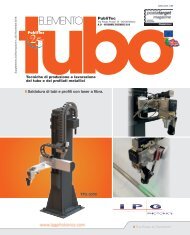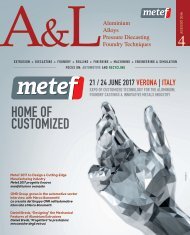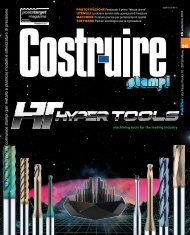PUB_INMOTION_n31_MARZO_2017_Interno96pag_160_PlanciaLR
You also want an ePaper? Increase the reach of your titles
YUMPU automatically turns print PDFs into web optimized ePapers that Google loves.
T ECNOLOGIA<br />
La burattatura di un<br />
organo di trasmissione<br />
Nella figura 1 viene presentato il processo su un disco di<br />
reazione, per applicazione su un trattore, sul quale viene<br />
chiaramente indicato che l’ottenimento della finitura superficiale<br />
Ra=0,8 deve essere ottenuto e garantito mediante<br />
burattatura.<br />
Il motivo per cui viene richiesta la finitura superficiale mel<br />
Un mozzo per sincronizzatore sottoposto a burattatura.<br />
l A synchronizer hub after the tumbling process.<br />
Anche il colore non è casuale ma dipende dal tipo di materiale,<br />
scelto a sua volta in base al tipo di acciaio che dovrà<br />
essere lavorato (acciaio da bonifica, cementazione, trattamento<br />
termico e così via.<br />
diante burattatura è dovuta alla necessità di non avere alcuna<br />
traccia di lavorazione, precludendo di fatto la possibilità<br />
dell’utilizzo di una qualsivoglia rettifica, anche se eseguita<br />
in modo che si ottengano tracce di lavorazione circolari,<br />
o di hard turning o tornitura dura che si voglia dire.<br />
L’esempio riportato è stato volutamente scelto perché, come<br />
vedremo, può aprire nuove prospettive nella lavorazione<br />
di altre tipologie di ingranaggi.<br />
La scelta imposta dal progettista è legata all’applicazione;<br />
infatti questi tipi di superficie normalmente sono a<br />
contatto con dischi frizione; sfregando su tale superficie,<br />
dovessero presentarsi delle tracce di lavorazione, le stesse<br />
si comportebbebero come degli utensili e asporterebbero<br />
materiale sul disco frizione riducendone la vita. Nel<br />
caso specifico bisogna anche considerare che l’intero<br />
pezzo viene sottoposto a burattatura e subisce quindi<br />
l’effetto dei media abrasivi. Nell’esempio presentato, essendo<br />
la superfice da finire quella esterna, l’attenzione è<br />
focalizzata su questa, nonostante il fatto che anche le altre<br />
superfici siano interessate dalla burattatura. Ovviamente<br />
non otterremo lo stesso risultato sulle altre superfici.<br />
Ad esempio, non tutta la superfice del dente sarà lavorata,<br />
ma gli spigoli esterni della dentatura, cioè le due<br />
facce dell’elemento saranno sicuramente smussate (spigoli<br />
vivi privi di bave) così come il diametro di centraggio<br />
dell’elemento.<br />
metal objects in a rotating machine in order<br />
to clean, round or smooth their surface. The<br />
pieces are put into the rotating barrel together<br />
with ceramic abrasives called “media” and<br />
appropriate chemical compounds, so as to<br />
obtain, depending on the need, a cleaning,<br />
smoothing, deburring or polishing effect. There<br />
are several parts that can be subjected to mass<br />
metal finishing: let’s mention only clutch plates<br />
to remain in the field of power transmission.<br />
The media used are of different types.<br />
About stones, or media, there are several types<br />
of stones in use. Their shape and size depends<br />
on the type of work they will have to do, and<br />
then, probably, a single stone will not meet all<br />
needs.<br />
The color is not random too, but it depends on<br />
the type of material, which, in turn, is selected<br />
according to the type of steel to be machined<br />
(quenched steel, carburizing, heat treatment<br />
andsoon).<br />
The tumbling process on a<br />
transmission component<br />
Figure 1 presents the reaction disc, for<br />
application on a tractor, on which it is clearly<br />
highlighted that a Ra = 0.8 surface finishing<br />
must be achieved and assured by the tumbling<br />
operation.<br />
The reason why surface finishing through<br />
tumbling process is required depends on the<br />
need of avoiding any machining marks, thereby<br />
foreclosing the possibility to use any kind of<br />
grinding, even if performed so as to achieve<br />
only circular machining marks, or hard turning.<br />
We chose this example because, as we shall<br />
see, it can open up new prospects in the<br />
machining of other types of gears.<br />
The designer’s choice is linked to the application;<br />
these types of surface are normally in contact<br />
with clutch plates; rubbing on this surface, in<br />
case machining marks appeared, these surfaces<br />
would act as tools and they will remove material<br />
on the friction plate and shorten its life. In this<br />
specific case, we should also consider that the<br />
entire piece is subjected to the tumbling process<br />
and then it is affected by abrasive media. In the<br />
example above, since the surface to be finished<br />
is the outer one, the focus is on this, despite the<br />
fact that also the other surfaces are affected<br />
by mass metal finishing. Obviously, we will not<br />
achieve the same results on other surfaces.<br />
For instance, not all of the tooth surface will<br />
be machined, but the outer edges of the teeth,<br />
that is the two faces of the part, will certainly be<br />
chamfered (sharp edges free of burrs), as well<br />
as the bore diameter.<br />
72 l marzo <strong>2017</strong><br />
PubliTec





